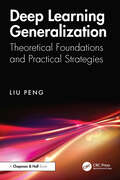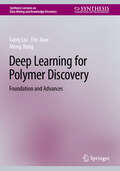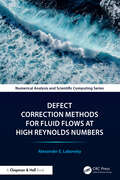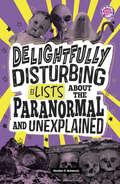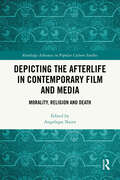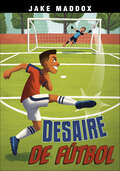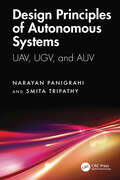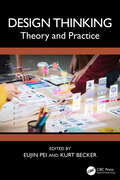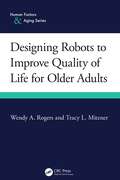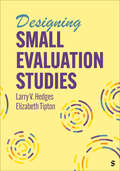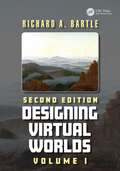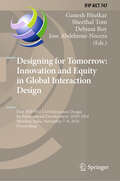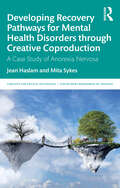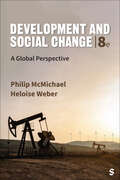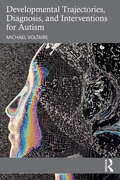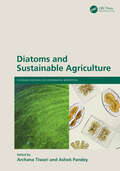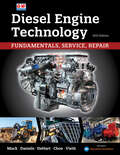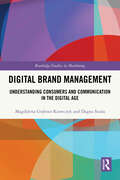- Table View
- List View
Deep Learning Generalization: Theoretical Foundations and Practical Strategies
by Liu PengThis book provides a comprehensive exploration of generalization in deep learning, focusing on both theoretical foundations and practical strategies. It delves deeply into how machine learning models, particularly deep neural networks, achieve robust performance on unseen data. Key topics include balancing model complexity, addressing overfitting and underfitting, and understanding modern phenomena such as the double descent curve and implicit regularization.The book offers a holistic perspective by addressing the four critical components of model training: data, model architecture, objective functions, and optimization processes. It combines mathematical rigor with hands-on guidance, introducing practical implementation techniques using PyTorch to bridge the gap between theory and real-world applications. For instance, the book highlights how regularized deep learning models not only achieve better predictive performance but also assume a more compact and efficient parameter space. Structured to accommodate a progressive learning curve, the content spans foundational concepts like statistical learning theory to advanced topics like Neural Tangent Kernels and overparameterization paradoxes.By synthesizing classical and modern views of generalization, the book equips readers to develop a nuanced understanding of key concepts while mastering practical applications.For academics, the book serves as a definitive resource to solidify theoretical knowledge and explore cutting-edge research directions. For industry professionals, it provides actionable insights to enhance model performance systematically. Whether you're a beginner seeking foundational understanding or a practitioner exploring advanced methodologies, this book offers an indispensable guide to achieving robust generalization in deep learning.
Deep Learning for Polymer Discovery: Foundation and Advances (Synthesis Lectures on Data Mining and Knowledge Discovery)
by Gang Liu Meng Jiang Eric InaeThis book presents a comprehensive range of topics in deep learning for polymer discovery, from fundamental concepts to advanced methodologies. These topics are crucial as they address critical challenges in polymer science and engineering. With a growing demand for new materials with specific properties, traditional experimental methods for polymer discovery are becoming increasingly time-consuming and costly. Deep learning offers a promising solution by enabling rapid screening of potential polymers and accelerating the design process. The authors begin with essential knowledge on polymer data representations and neural network architectures, then progress to deep learning frameworks for property prediction and inverse polymer design. The book then explores both sequence-based and graph-based approaches, covering various neural network types including LSTMs, GRUs, GCNs, and GINs. Advanced topics include interpretable graph deep learning with environment-based augmentation, semi-supervised techniques for addressing label imbalance, and data-centric transfer learning using diffusion models. The book aims to solve key problems in polymer discovery, including accurate property prediction, efficient design of polymers with desired characteristics, model interpretability, handling imbalanced and limited labeled data, and leveraging unlabeled data to improve prediction accuracy.
Defect Correction Methods for Fluid Flows at High Reynolds Numbers (Chapman & Hall/CRC Numerical Analysis and Scientific Computing Series)
by Alexander E. LabovskyDefect Correction Methods for Fluid Flows at High Reynold’s Numbers presents the mathematical development of defect correction methods (DCM) in application to fluid flow problems in various settings. We will show several approaches to applying the DCM ideas in computational fluid dynamics (CFD) – from a basic idea of controlling the flow by the means of increased diffusion, to the state-of-the-art family of novel, DCM-based turbulence models. The main idea of the methods presented in this book, is to use defect correction in turbulence modelling; additionally, several methods will also be presented, that aim at reducing the time discretization error.Features · Provides a road map, starting from the ideas of minimally invasive controlling of turbulent flows, to the ways of improving the existing regularization techniques with DCM, to the ideas of ‘full defect correction’ in both space and time and, finally, to the more complex embedding of the DCM into turbulence modelling by the ‘correction’ of the whole turbulence model· Can be used for teaching a topics course on a Masters or Ph.D. level. It is even more suitable as a reference for CFD theorists and practitioners, with most of the methods being minimally invasive and, therefore, easy to implement in the existing/legacy codes· Discusses the current challenges in turbulence modelling with defect correction, showing several possible directions for future developments. Two source codes are provided – one for a regularization technique and another for a novel turbulence model – in order to give an interested researcher a quick start to the topic of DCM in CFD.
Delightfully Disturbing Lists About the Paranormal and Unexplained
by Heather E. SchwartzSpooky season can be all year long when the scariest, most spine-tingling facts are collected in this book of delightfully disturbing lists. Chapters make the content event more digestible. Full-color images and inviting designs will engage readers’ minds and get them excited to learn more.
Depicting the Afterlife in Contemporary Film and Media: Morality, Religion and Death (Routledge Advances in Popular Culture Studies)
by Angelique NairnWhat lies beyond death? This book brings together a diverse collection of scholarly voices to explore how popular culture imagines—and reimagines—the afterlife. Drawing from film, television, video games, literature, advertising, and digital technologies, this book examines how narratives about Heaven and Hell, ghosts and gods, memory and immortality shape contemporary understandings of morality, death, and what may come after.From Pixar’s Coco to The Good Place, Ghostbusters, Upload, and Westworld, these chapters interrogate the enduring power of afterlife narratives to provide existential comfort, moral guidance, and cultural critique. Whether through the lens of theology, philosophy, or secular imagination, contributors consider how popular media blurs the sacred and the profane, challenging dogma, reframing ethics, and offering new possibilities for how we remember the dead and live among the living.Spanning topics such as queer love in the afterlife, Indigenous cosmologies, digital resurrection, and the theological implications of robots, Depicting the Afterlife in Contemporary Film and Media: Morality, Religion and Death is a timely exploration of how the afterlife continues to haunt and inspire modern culture.Essential reading for scholars of media studies, religious studies, cultural theory, and anyone fascinated by humanity’s oldest and most enduring question: what happens when we die?
Dermoscopy of the Hair and Nails 3e
by Antonella Tosti Andrea SechiThis new edition of a bestselling text almost amounts to a completely new book, with over 750 figures of common and uncommon disorders, including new chapters on trichoscopy of hair transplantation, teletrichoscopy, and trichoscopy of the shaved scalp. The chapters also list the key clues that are important to help the practitioner reach the correct diagnosis about problems with hair or nails."Numerous high-quality photos are helpful in demonstrating key features" (Doody’s Reviews) [of the previous edition]
Desaire de fútbol
by Jake MaddoxDespués de trabajar duro en la temporada baja, Quincy está emocionado de ascender a un equipo de fútbol de primer nivel y jugar con su amigo Will. Pero el resto de sus nuevos compañeros de equipo en los Vipers no están tan entusiasmados. Le dan la espalda a Quincy, lo que le dificulta encontrar su ritmo. Pero pronto, Quincy comienza a ganarse algo de respeto. Entonces su entrenador lo cambia a la alineación titular y mueve a Will al banco. ¿Podrá Quincy encontrar una manera de que Will vuelva al juego? ¿O su amistad flaqueará por el repentino desaire futbolístico? ¡Descúbrelo en este emocionante libro de capítulos fácil de leer de Jake Maddox! After working hard in the off-season, Quincy is thrilled to move up to a top-level soccer team and play with his friend Will. But the rest of his new teammates on the Vipers aren&’t so excited. They give Quincy the cold shoulder, making it difficult for him to find his groove. But soon, Quincy begins to earn some respect. Then his coach shifts him into the starting lineup—and moves Will to the bench. Can Quincy find a way to get Will back in the game? Or will their friendship falter over the sudden soccer snub? Find out in this exciting, easy-to-read chapter book by Jake Maddox!
Design Principles of Autonomous Systems: UAV, UGV, and AUV
by Narayan Panigrahi Smita TripathyThis book explains unmanned systems including Unmanned Aerial Vehicles (UAVs), Autonomous Underwater Vehicles (AUVs) and Unmanned Ground Vehicles (UGVs). It also details system and subsystem compositions and their basic design. The components/subcomponents, employed payloads and sensors, and communication systems used to compose the autonomous system are discussed. It examines generic applications of these unmanned systems including specific missions for which they are employed. Other topics like swarm of drone, anti-drone system, and some algorithms used in navigation and communication of the drone are also discussed.Some key features: Helps readers understand nuances of autonomous systems on land, in air, and in sea. Explains pertinent design principles, sensors, and communication system. Lays the foundation for crafting, designing, and deploying autonomous systems for different applications. Reviews algorithms, computing, control and technology stacks required for design of UAS. Discusses software and navigation aspects of autonomous systems with the concepts of SLAM. This book is aimed at graduate students and researchers in mechatronics engineering, systems and sensors, systems and control, and aerospace engineering.
Design Thinking: Theory and Practice
by Kurt Becker Eujin PeiThis book aims to provide readers with an in-depth understanding of design thinking by documenting the personal insights of professionals and practitioners from a wide range of disciplines. Design Thinking: Theory and Practice refers to a series of cognitive, strategic, and practical steps used during the process of designing, and the context of how people reason when they engage with solving problems. The scope of this book focuses on topics such as problem-solving, systems thinking, innovation, and the role of design in product design and services. This book is unique as it brings together "stories" from both academics’ and practitioners’ perspectives, enabling readers to view design thinking from many different perspectives that can be applied in every-day life situations or for organizations when developing plans and policies. This book would be essential reading for design engineers, industrial designers, and mechanical engineers who have interest in design thinking.
Designing Robots to Improve Quality of Life for Older Adults (Human Factors and Aging Series)
by Wendy A. Rogers Tracy L. MitznerWith adults over sixty becoming an ever-increasing proportion of the global population, the challenge of accommodating the needs, preferences, and abilities, of this heterogeneous population has increased. One such method is with robots, which can be used to support everyday activities for older adults and enhance their quality of life. Older adults have been found to be quite open to the idea of interacting with robots, albeit with preferences for the nature of the task they want the robots to do. This book provides a comprehensive state-of-the-art review of the topic of designing robots for older adults.This book translates research on aging, human factors, and human-robot interaction (HRI) into guidance that will be usable for practitioners who design robots for a range of applications. It offers a framework for HRI with a focus on personal characteristics, robot functionality, task demands, and interaction context. The application of this HRI framework for older adults provides the basis for the book. It covers the fundamentals of aging, a review of the different types of robots available now and in the future, the known facilitators and barriers for adoption and the potential of robots for different everyday activities including social engagement, health and wellness, home maintenance and security. Throughout, the authors emphasize the need to follow fundamental human factors processes and participatory design approaches that engage older adults in the design process, thus allowing the reader a thorough and contemporary understanding of robots as an essential future for assisting an aging population.Designing Robots to Improve Quality of Life for Older Adults is intended for a broad professional audience, especially the design community, gerontologists, and human factors/ergonomics practitioners. It will also be suitable for students at the undergraduate and graduate level as a supplementary textbook for courses in human factors, design for aging, and HRI.
Designing Small Evaluation Studies
by Larry V. Hedges Elizabeth Tipton"The book will be an important addition to instruction in designs for causal inference in the field of education. It is long overdue." - Thomas J. Lipscomb, The University of Southern Mississippi This text describes how to design and analyze small efficacy or evaluation studies, typically carried out as part of the development of programs or interventions in areas such as education. The problem facing many researchers is how to design a study that is as small as possible, yet big enough to yield relatively unambiguous evidence about an intervention’s average effect. This text begins with an overview of validity, causal inference, statistics, effect sizes, and measurement. The authors then focus on designs for small, randomized trials, followed by a section on non-randomized causal designs: here they focus on three designs most useful for small studies including the non-equivalent control group, difference-in-difference, and interrupted time series designs. The final section summarizes the book, compares designs, discusses approaches to choosing a design, and provides guidance on reporting. Five case examples are used throughout the book to illustrate the material and there is a glossary of terms and concepts.
Designing Small Evaluation Studies
by Larry V. Hedges Elizabeth Tipton"The book will be an important addition to instruction in designs for causal inference in the field of education. It is long overdue." - Thomas J. Lipscomb, The University of Southern Mississippi This text describes how to design and analyze small efficacy or evaluation studies, typically carried out as part of the development of programs or interventions in areas such as education. The problem facing many researchers is how to design a study that is as small as possible, yet big enough to yield relatively unambiguous evidence about an intervention’s average effect. This text begins with an overview of validity, causal inference, statistics, effect sizes, and measurement. The authors then focus on designs for small, randomized trials, followed by a section on non-randomized causal designs: here they focus on three designs most useful for small studies including the non-equivalent control group, difference-in-difference, and interrupted time series designs. The final section summarizes the book, compares designs, discusses approaches to choosing a design, and provides guidance on reporting. Five case examples are used throughout the book to illustrate the material and there is a glossary of terms and concepts.
Designing Virtual Worlds Volume I
by Richard A. BartleDesigning Virtual Worlds, authored by a true pioneer, stands as the most comprehensive examination of virtual-world design ever written. This seminal work is a tour de force, remarkable for its intellectual breadth, encompassing the literary, economic, sociological, psychological, physical, technological, and ethical foundations of virtual worlds. It provides readers with a profound, well-grounded understanding of essential design principles.This first volume presents a rich, well-developed exploration of the foundational concepts underpinning virtual worlds. Tracing the evolution of such games from their inception, it draws upon examples ranging from the earliest MUDs to today's expansive MMORPGs. It elucidates fundamental design precepts often forgotten in the development of new games.No other book on online games or virtual worlds matches the level of detail, historical context, and conceptual depth found in Designing Virtual Worlds.
Designing Virtual Worlds: Volume I
by Richard A. BartleDesigning Virtual Worlds, authored by a true pioneer, stands as the most comprehensive examination of virtual‑world design ever written. This seminal work is a tour de force, remarkable for its intellectual breadth, encompassing the literary, economic, sociological, psychological, physical, technological, and ethical foundations of virtual worlds. It provides readers with a profound, well‑grounded understanding of essential design principles.This first volume of the second edition presents a rich, well‑developed exploration of the foundational concepts underpinning virtual worlds. Tracing the evolution of such games from their inception, it draws upon examples ranging from the earliest MUDs to todayʼs expansive MMORPGs. It elucidates fundamental design precepts often forgotten in the development of new games.No other book on online games or virtual worlds matches the level of detail, historical context, and conceptual depth found in Designing Virtual Worlds.
Designing for Tomorrow: First IFIP WG 13.8 Interaction Design for International Development, IDID 2024, Mumbai, India, November 7–9, 2024, Proceedings (IFIP Advances in Information and Communication Technology #747)
by Ganesh Bhutkar Sheethal Tom Debjani Roy Jose Abdelnour-NoceraThis book constitutes the refereed proceedings of the First IFIP Working Group 13.8 Interaction Design for International Development, IDID 2024, held in Mumbai, India, during November 7–9, 2024. The 14 full papers included in this book were carefully reviewed and selected from 17 submissions. The aim of this working group is to pursue research and promote the discipline of Human-Computer Interaction (HCI) in an international context. It also provides a platform, where both emerging and experienced researchers from academia and industry can converge to exchange their latest findings in the ever-evolving realm of HCI and International Development.
Designing the Complex City: A Systemic Approach to Spatial Design
by Elena PorquedduHow can designers address the emergent self-organizing nature of complex urban environments? Designing the Complex City highlights how both an excess and a lack of design control might contrast the lively complexity of cities, their adaptive and evolutionary capacity. By using key concepts from systems thinking, complexity sciences, life sciences, cognitive sciences, and social sciences, the book frames a systemic spatial design approach aimed at enhancing the potential of different spatial design disciplines to navigate place-specific emergent transformations without overdetermining their formal outcome. A range of heterogeneous case studies, developing at different scales, show how embracing a design approach that is embodied, open-ended, contextually responsive, incremental and adaptive does not question the relevance of designers’ specific skills in shaping the physical structure of cities; it may rather increase their potential to effectively intervene in complex adaptive cycles of urban decay and self-regeneration.Designing the Complex City provides insights for students, researchers, and academics in architecture, interior design, urban and landscape design, planning theory, and urban studies. It is essential reading for all designers who seek to proactively and meaningfully intervene in spontaneous socio-spatial dynamics.
Developing Global Competence in World Language Education: A Four-Step Framework for Success
by Soyhan Egitim Seiko HarumiThis book presents a four-step framework to help English as a world language (EWL) learners successfully develop global competence, which is defined as the skills, values, and behaviors that prepare young people to thrive in diverse environments. The book showcases practical methods and strategies supported by autoethnography and empirical studies to detail the four elements of the framework towards developing global competence: English language proficiency, cross-cultural knowledge, adopting flexibility in oral communication, and embracing values beyond our horizons. While the English language and culture provide essential input for effective communication, developing flexibility in communication styles and viewing conflict as an opportunity for growth can help L2 learners navigate intercultural encounters more effectively and achieve cross-cultural adaptation. This text will be beneficial to language learners, intercultural communication majors, researchers, and educators in TESOL/EFL/ESL programs, as well as in-service teachers of English language learners (ELLs).
Developing Recovery Pathways for Mental Health Disorders through Creative Coproduction: A Case Study of Anorexia Nervosa (Concepts for Critical Psychology)
by Jean Haslam Mita SykesThis book explores the potential of Creative Coproduction as a recovery tool for severe mental disorder, using case study examples of service users with anorexia nervosa. Written by authors with expertise in both mental health provision and experience of mental health services, the book advocates a creative, coproductive approach to treating mental disorders. Creative Coproduction involves significant interaction and collaboration between health and social care professionals, sufferers, recovered patients, educational establishments, families and scientists at all levels of interaction. The book emphasises the importance of working together creatively as a diverse yet cohesive team, adding to existing knowledge through every interaction and discovering and developing alternative recovery pathways. It challenges the stigma faced by people with mental health difficulties, using Foucault’s concept and theory of unreason. The book further uses the neuroscience of creativity as a lens by which to identify creative characteristics and actions, discussing ways this can be harnessed to transform recovery pathways through creative practices. Centering the voices of service users and their families alongside mental health professionals, this important book will be valuable reading for advanced undergraduate and postgraduate students in health and allied sciences, mental health and social work programmes. It will also be highly relevant for health and social care professionals including mental health nurses, allied practitioners, managers of community mental health teams and community practitioners.
Development and Social Change: A Global Perspective
by Philip McMichael Heloise WeberDevelopment and Social Change explores the historical, socio-political, and ecological aspects of development. The Eighth Edition critically engages with the concept of development, tracing its roots and examining its implications in the contemporary world. Authors Philip McMichael and Heloise Weber use case studies and examples to help describe a complex world in transition. Students are encouraged to see global development as a contested historical project. By showing how development stems from unequal power relationships between and among peoples and states, often with planet-threatening environmental outcomes, it enables readers to reflect on the possibilities for more just social, ecological and political relations.
Development and Social Change: A Global Perspective
by Philip McMichael Heloise WeberDevelopment and Social Change explores the historical, socio-political, and ecological aspects of development. The Eighth Edition critically engages with the concept of development, tracing its roots and examining its implications in the contemporary world. Authors Philip McMichael and Heloise Weber use case studies and examples to help describe a complex world in transition. Students are encouraged to see global development as a contested historical project. By showing how development stems from unequal power relationships between and among peoples and states, often with planet-threatening environmental outcomes, it enables readers to reflect on the possibilities for more just social, ecological and political relations.
Developmental Trajectories, Diagnosis, and Interventions for Autism
by Michael VoltaireThis book introduces a developmental psychopathology approach to exploring the concept of autism in terms of three broad domains of development— physical, cognitive, and psychosocial—that are inextricably linked.Developmental psychopathology focuses on the interplay between normal and abnormal development. The juxtaposition of typical and atypical developmental patterns can better inform clinicians and parents of possible signs of achievement milestones that are missing or falling behind. This book consists of twelve chapters grouped under four parts, with each chapter's core content based on the most recent research findings and ending with the author's reflections on various parts of the chapter and a summary of the main points discussed. A final chapter addresses topics of utmost importance rarely discussed in books on autism.Appropriate for a wide range of professionals who work with clients who have autism, this book is a unique resource with approaches often overlooked in most books on autism.
Dharma and Detachment: Writings on Indian and Tibetan Thought
by Simone WeilSimone Weil was one of the most profound and thought-provoking thinkers of the twentieth century. An intellectual prodigy from an early age in both the sciences and the arts, she was at different times a teacher, factory and farm labourer, and political activist, spending a brief period in Spain during the Spanish Civil War. Her writings, which span philosophy, politics, religion and spirituality, are marked by a both passionate and contemplative attempt to understand profound questions about the good, God, human thought and action, and suffering and beauty.However, considerably less known is Weil's fascination with the texts and ideas of Indian and Tibetan thought, which she both thought and wrote about extensively. Dharma and Detachment: Writings on Indian and Tibetan Thought is the first volume to draw together some of Weil's most interesting and important writings on eastern thought.Expertly edited and introduced by Nicolas Bommarito, the anthology contains writings drawn from Weil's extensive Notebooks. The extracts show how she moves seamlessly between Plato, Catholicism, mathematics, the Bhagavad-Gītā, and Buddhism, engaging with texts in the original Sanskrit. To help the reader gain a full insight into Weil's thought, the volume also includes – along with Weil's own writings – key passages from the classical texts that inspired her, especially the Bhagavad-Gītā and the Upanis.ads.In addition to a helpful Introduction by Nicolas Bommarito setting out the background to Weil's life and her engagement with Indo-Tibetan texts, he also explains fundamental Indo-Tibetan philosophical terms such as ātman, the three gunòas, karma and detachment. A glossary is also included, making the volume an ideal starting point for those unfamiliar with Indo-Tibetan philosophy and seeking a clear path into Weil's engagement with these texts and ideas.Dharma and Detachment: Writings on Indian and Tibetan Thought will be of great interest to all readers and students of Simone Weil's work, as well as to those interested in Indian and Tibetan philosophy, religion, and phenomenology.
Diatoms and Sustainable Agriculture (Sustainable Industrial and Environmental Bioprocesses)
by Archana TiwariThis book highlights the multifaceted role of diatoms in revolutionizing agricultural practices toward sustainability. The introductory chapter of Diatoms and Sustainable Agriculture examines the fundamental role of diatoms in fostering a circular economy within the agricultural sector, discussing the challenges and prospects associated with integrating diatoms into sustainable agricultural practices. Additionally, it reviews the potential of diatoms as natural plant growth promoters, elucidating the mechanisms through which these microorganisms enhance crop productivity while reducing reliance on synthetic fertilizers and pesticides. The chapter also covers the pivotal role of diatoms in agricultural watersheds, serving as indicators of ecosystem health and guiding strategies for maintaining river integrity. Furthermore, the book introduces the potential of diatoms for agricultural wastewater bioremediation and applications of diatom frustules as biosensors for the early detection of plant pathogens. The subsequent chapters explore the current status and future prospects of diatoms as insect control agents, highlighting their potential as environmentally friendly alternatives to conventional pesticides. Toward the end, the text delves into the intersection of artificial intelligence and diatom microalgae-based agriculture. This book serves as an important source for researchers and academicians in phycology, biotechnology, and agricultural sciences.
Diesel Engine Technology
by James P. Mack Jason A. Daniels Mark A. DeHart J. Gene Choe Kevin D. ViethDiesel Engine Technology covers the design, construction, operation, diagnosis, service, and repair of both mobile and stationary diesel engines. Content relates to on- and off-road vehicles, as well as marine, agricultural, and industrial applications. This text is a valuable resource for anyone involved in the service and repair of diesel engines, as well as those preparing for ASE Medium/Heavy Truck Test T2—Diesel Engines, Test T6—Electrical/Electronic Systems, and Test T8—Preventive Maintenance Inspection.
Digital Brand Management: Understanding Consumers and Communication in the Digital Age (Routledge Studies in Marketing)
by Magdalena Grębosz-Krawczyk Dagna SiudaIn today’s fast-evolving digital landscape, branding has transcended traditional boundaries, becoming a dynamic and multifaceted process. This book provides an in-depth exploration of brand management in the digital world, covering its historical evolution, theoretical foundations, and strategic applications. It delves into brand positioning, consumer perception, and the role of digital media in shaping brand image. Furthermore, it highlights integrated communication strategies and the significance of virtual brand communities in fostering brand loyalty. The authors examine emerging trends in digital branding, such as AI-driven personalization, user experience and platformization, and algorithmic branding, emphasizing their impact on consumer engagement and brand differentiation. It also addresses the ethical challenges of digital brand management, including data privacy, transparency, and authenticity, underscoring the importance of responsible brand stewardship in a competitive and rapidly evolving digital environment.This book serves as a comprehensive guide for scholars and academics across marketing, brand management and consumer behaviour.
